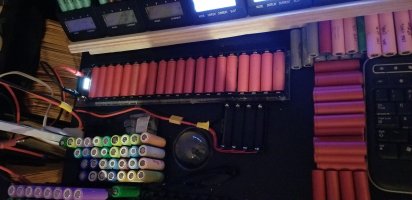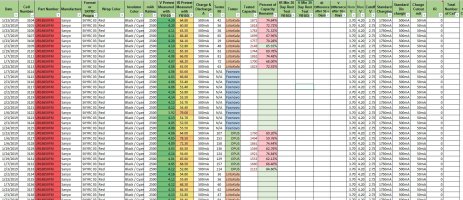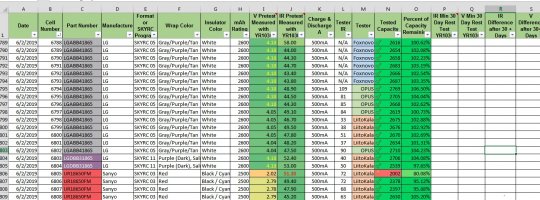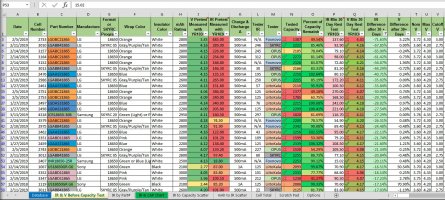Wolf
Moderator
- Joined
- Sep 25, 2018
- Messages
- 2,009
I started this to show how to process Low V cells. At least how I do it and have had a reasonablegood success rate.
As you all know we run into those packs that just have a bunch of < 1V cells. What to do?
First off we know the cell is mechanically OK as there is some V so no CID trip or PTC issues.
At <1 V there is not much charge to worry about so I line them up in my 20P cell holder.
These are Sanyo UR18650FM all of them were <1V

I have a CC/CV BuckPower Supply hooked up to my modified Server Power Supply for 12V input andI set my CC/CV Buck to 4.2V and 1A.
That equates to 50mA per cell.
This picture shows some of the Sony "greens" being charged US18650GR G8 Theones that are inSony green cells suck thread

Next I watch the Vbuild up and check the cell temperatures by hand.
(Thermal Imaging camera coming today If you want one that is a good unit and at a great price I got this one.https://perfectprime.com/collections/thermal-imaging-camera/products/ir0018)
After about 1 to 2 hrs you will notice some cells getting a little warmer than the others. I will have Thermal images in the future but for now I use a thermalgun and most cells will run around 22C to 25C. Then you get to the 27C and up cells. At this point you will notice on the DMM that the V has somewhat stalled at a certain V and doesn'tseem to rise anymore.
That means the high temp cells are absorbing all the A and are sucking the V down.
So I removed the "hot cells" and immediatelythe V started to rise.You can view the video here(Too big to post here)
Now you will see that the rise is inthe thousands of a volt so it would not show up on a regular DMM.
As the offending cells have been pulled out the remaining ones are now able to absorb a charge. What is to note though is that the IR of the "hot"cellswasn't bad at least not in the ionosphere.
I will make more detailed pictures and possibly more short videos of this process. as it continues.
Hope this explains some things.
Wolf
As you all know we run into those packs that just have a bunch of < 1V cells. What to do?
First off we know the cell is mechanically OK as there is some V so no CID trip or PTC issues.
At <1 V there is not much charge to worry about so I line them up in my 20P cell holder.
These are Sanyo UR18650FM all of them were <1V

I have a CC/CV BuckPower Supply hooked up to my modified Server Power Supply for 12V input andI set my CC/CV Buck to 4.2V and 1A.
That equates to 50mA per cell.
This picture shows some of the Sony "greens" being charged US18650GR G8 Theones that are inSony green cells suck thread

Next I watch the Vbuild up and check the cell temperatures by hand.
(Thermal Imaging camera coming today If you want one that is a good unit and at a great price I got this one.https://perfectprime.com/collections/thermal-imaging-camera/products/ir0018)
After about 1 to 2 hrs you will notice some cells getting a little warmer than the others. I will have Thermal images in the future but for now I use a thermalgun and most cells will run around 22C to 25C. Then you get to the 27C and up cells. At this point you will notice on the DMM that the V has somewhat stalled at a certain V and doesn'tseem to rise anymore.
That means the high temp cells are absorbing all the A and are sucking the V down.
So I removed the "hot cells" and immediatelythe V started to rise.You can view the video here(Too big to post here)
Now you will see that the rise is inthe thousands of a volt so it would not show up on a regular DMM.
As the offending cells have been pulled out the remaining ones are now able to absorb a charge. What is to note though is that the IR of the "hot"cellswasn't bad at least not in the ionosphere.
I will make more detailed pictures and possibly more short videos of this process. as it continues.
Hope this explains some things.
Wolf



















